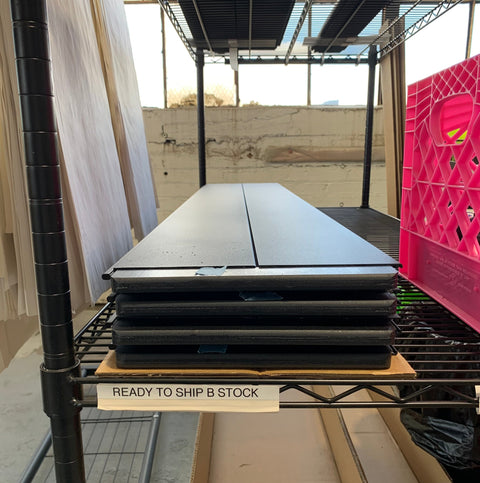Everyone’s got ideas. Fewer people build them. Even fewer survive the part where their “brilliant solution” snaps in half during install attempt #3. But if you’re still here — still sketching, testing, breaking, rebuilding — you’re one of us!
This list is about the real stuff: the tools and mindsets that make invention possible, from the first sketch to the first successful shipment (and every weird in-between step where you rethink your life choices in a Lowe’s parking lot). Here’s what we’ve learned.
1. A “version zero” mindset — everything’s a prototype
Nothing’s finished the first time. Honestly, nothing’s finished the fifth time either.
If you can look at your work and say, “Well, it doesn’t suck yet, but it will,” then congrats, you’re in the right headspace. Version Zero isn’t a failure. It’s the first real version that shows you where the failure is hiding.
The more you fall in love with prototyping, the more likely you are to end up with something that lasts.
2. Get yourself one tool that doesn’t suck
We all have one. That perfect clamp. The drill with the trigger wear. A battered 8mm ratcheting wrench that’s bailed you out more times than it should. Maybe it’s a reliable 3-D printer or lathe. Whatever it is, this workhorse tool should make up the backbone of your core processes.
You don’t have to spend a fortune, but you do need at least one tool you reach for without thinking. The kind that feels like part of your hand. It’s a trust thing. And it’ll anchor you when everything else in your workspace is on fire (sometimes literally).
3. One tool you probably shouldn’t, but use anyway
Look. Every builder has a rogue agent in their toolbox — a thing that should be in the trash, but somehow keeps showing up like it belongs there. You know what we’re talking about.
We’ve got a heat gun here that only speaks in “blast furnace.” No low setting, no warning, just full send. If you hesitate for even a second, you’re warping polymer like you’re shrink-wrapping someone’s sins. Or consider our ratchet that slips just enough to be dangerous, but only under load, and only when you’ve got your face real close to the work. It’s a game. The ratchet might win.
There’s a soldering iron on Bill’s bench with a melted cord and no base. It balances on a ceramic coffee mug like some kind of burnout Jedi weapon. Is it OSHA approved? Absolutely not. Is it so unsafe that it now functions as a sort of metal mascot / paperweight when the windows are open in the office? Well, yes.
These tools are cursed. But they’ve been there. They’ve helped rig last-minute solutions when the nice tools were too precise to improvise. They’ve taught us restraint, timing, and when to stop pushing our luck. The point isn’t “use broken tools.” The point is that invention requires familiarity and taking risks. You learn the quirks. You adapt. You get better not by always using the right thing, but by learning how to make whatever you’ve got do the job.
That’s the difference between a designer and a builder: one waits for the right conditions. The other finds a way anyway.
4. Friends who ask annoying, smart questions
Yes, they're the worst. But also, they're essential.
You need at least one person who will squint at your prototype and say, “Wait, why is this side longer?” Or worse: “What’s it for, though?” They’re not trying to be mean (usually). They’re helping you see the thing that your hyper-focused brain is glossing over. Inventors get tunnel vision fast — especially when you’re deep in version four-point-oh-no — and a fresh set of eyes can save you from over-engineering yourself into a corner.
If you're lucky, your annoying question-asker is also good at holding stuff while you drill. Keep them fed. Let them name the prototype. They’ve earned it.
5. A failed project you still think about
We all have that one. The thing that almost worked. The gear you couldn’t quite get aligned. The idea that felt so solid until it fell apart in the field or on install or in your hands right before a customer demo.
And yet… you still think about it. That’s good. That’s important. Because failure isn’t just a teacher, it’s a reference point. Every future idea is shaped by what didn’t work before. Maybe the timing was wrong. Maybe you were under-resourced. Maybe the solution needed more swearing. Whatever it was, you learned from it. And sometimes those shelved ideas come back around, better than before.
6. A reason to build beyond “I could make money on this”
We won’t pretend money doesn’t matter, because it absolutely does. You deserve to eat, to rest, to pay rent and fix your truck when the prototype tray slams open because you forgot a lock stop. Heck, we do, too, which is why we get after it day in and day out.
But the inventors who last, the ones who keep pushing, are almost always the ones with a deeper reason to keep building. Curiosity. Frustration. The joy of solving something. A need to make things better for people like you. Money’s a motivator, but it’s not a compass.
When your hands are covered in epoxy and your 3D printer has just eaten its own stepper motor for breakfast, it’s not your margins that get you through. It’s the part of you that still wants to see it work. Build for that. Build for the story. Build because you still think it might matter, even if nobody’s watching yet.



Comments (0)
There are no comments for this article. Be the first one to leave a message!